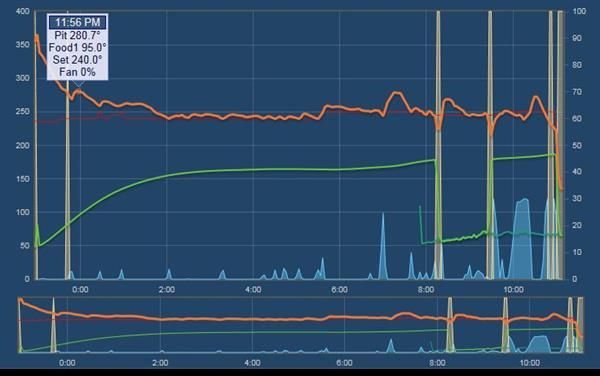Thanks for the feedback...
I just got my HM wired up yesterday and did my first cook so I have a better idea what's going on.
From that experience I think what I had proposed would work and would be an appropriate way to aid the initial warm up of the smoker.
Here's some info on what I have setup here so I can explain myself.
Right now I have a Char Broil H2O Smoker Deluxe that I got at a garage sale. (a bigger DIY pit is in my near future) It is a rather bogus design without even one adjustable vent and no vents in the lid. There is a coal pan that sits in the base, the coal pan only has a 1" hole in the bottom, the base has 3 larger holes in it.
What I did to integrate the HM into this smoker was first I used Aluminum tape to cover over two of three holes in the base. Then I used 3/4" copper tubing to make what looks kinda like burners in a gas grill which sit in the bottom of the coal pan, flexible copper comes out of the hole in the coal pan and goes out through the one hole in the base that I didn't tape over, then the blower connects to the end of the flexible tube. I drilled holes in the copper tubes in the coal pan so the air is distributed evenly through the coal pan. This choked off most of the natural convection flow of air through the smoker allowing the HM to regulate the fire better by controlling the air flow more completely.
When I fired up the smoker I hit the coals with torch for a few and powered up the HM, the fan ran at 100% initially. The fan stoked the fire nicely to get it up to temperature (as is my goal with the above suggestion to add a fan for the initial warm up in the servo system). Once I put the body on the smoker and pit probe in place the temp started to rise, as expected when the temperature started rising toward the set point the fan ramped down and the temp settled nicely at the set point (no over shoot). During the cook the fan ran roughly between 0 to 13% capacity oscillating up and down in a natural almost sine wave looking graph. The pit temperature however stayed ROCK SOLID, the graph of pit temperature sat right on top of the red line and barely deviated at all, the line was much more flat than the line I see in the graph you posted from your cook.
I experimented a bit and changed the set point from 250 to 275, the fan ramped up and the pit temp went right up to 275 in no time and held it perfectly (no overshoot). I set it back to 250 and the fan turned off, the pit dropped right to 250 and stopped on a dime and resumed the near perfect temperature control in the pit. Even when I opened the lid, right after the lid open mode ended the fan stoked the pit right back to perfect temperature in no time! Great design on this thing I tell ya!
IMHO (from reading through the forum) some HM users are not choking off the natural convection air flow enough to allow the HM to do its job. If you let too much air flow on its own the HM is helpless to choke off the fire and overshoot is going to happen as a result. If you do limit the amount of convection flow the HM fan can do its job of providing just the right amount of air to stoke the fire to the desired temperature, and if the temp is heading too high it has the ability to choke it off and control it.
I really wish I had grabbed a screen shot of the graph before I powered down the rPi, the pit temp was a rock solid flat line right across the target temperature, pretty amazing! I guess I can get that done next cook....
Back to the servo setup. From my experiment above I think my suggested method of using a fan to stoke the pit up to temperature would work out great. The set point where the fan kicks off does not have to be <100%, you could tune that by adjusting the switch that activates the fan, using the arm from the servo damper to actuate the switch. I guess it would not be "required" for operation, but if you are used to the HM fan stoking up your coals for you it might take some getting used to waiting for the passive servo system to get your pit up to temperature initially.
At least these are my observations thus far....
Thanks to everyone who put hard work into this project to make it happen, and to everyone who shares info and tries to help people out in the forum. Thanks to you all I have accomplished my goal of a WiFi enabled smoker controller at a fraction of the cost of the products available on the market today....
EDIT:
Here is a picture of the air delivery system I made for my smoker, I guess I'll call it the "air burner". With the convection vents all closed off the HM controls the air flow and holds the temp like a good oven! I'll post more pics of the whole smoker in the thread I made about my initial powerup of my HM.



